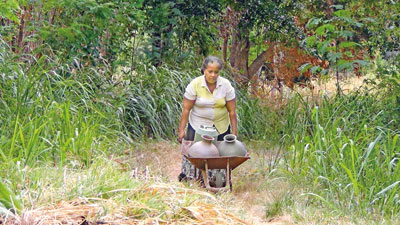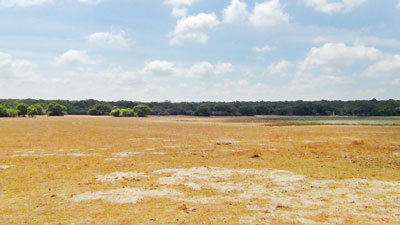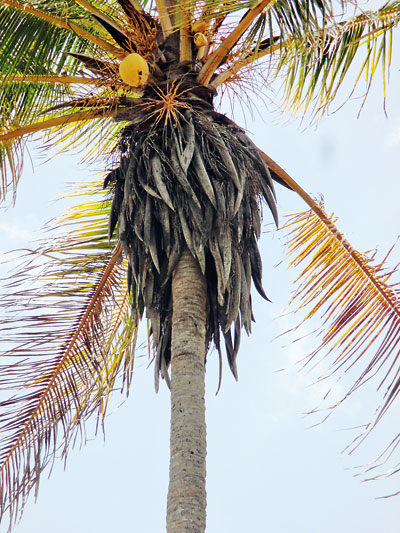News
600,000 people in 12 rainless districts cry for drinking water and relief
Twelve agriculture-dependent districts in three provinces have been affected by a drought so severe that some 600,000 people have little or no water to drink unless the local council or disaster management officials send bowsers.

Karuwalagaswewa - Nearly dried up water tank. Pix by Jayarathna Wickramaarchchi
All districts of the Northern, Eastern and North Central Provinces have been severely affected by the drought. The Jaffna, Kilinochchi, Mannar, Anuradhapura and Batticaloa districts are among the worst hit in terms of the numbers of affected people.
Facing the daunting prospect of having to provide relief supplies to the victims, the Disaster Management Ministry is giving priority to providing drinking water through the Divisional Secretariats and local councils, Ministry Secretary Sisira Kumara said.
He said the situation in the North Central Province was of particular concern as most of the smaller tanks in the province had completely dried up. To mitigate the crisis, Cabinet approval was obtained last week for urgent allocation of Rs. 200 million to dig new wells and to deepen the existing one, he said.
District Secretaries from the worst affected areas have proposed that the Government resume the distribution of Rs. 5,000 worth drought ‘relief packs’ containing essential items. The distribution of relief packs was stopped in April with the districts experiencing some rain in April. Mr Kumara said Cabinet approval would have to be obtained to resume the programme.
Of the 244,000 families in the Anuradhapura district, 50 percent were engaged in agriculture. Some 13,000 of those families, comprising about 86,000 people outside the Mahaweli region, have seen three successive harvests fail due to the prolonged drought, according to Anuradhapura District Secretary R.M. Wanninayake.
“The drought is affecting nine Divisional Secretariat Divisions. Except for the Mahaweli region, most of the water sources in the district have dried up. Even the supply of water to Anuradhapura town is a struggle as the Nuwara Wewa, the main water source in the area, has mostly dried up,” he said.
Water shortages brought on by the drought also prevented the reopening of the main campus of the Rajarata University this week.
Four faculties at the university’s Mihinthale campus were due to reopen for academic activities on Monday, September 3 after they were shut down in August after several students were afflicted with chickenpox.
Vice Chancellor Ranjith Wijewardena told the Sunday Times that plans to resume academic activities were put on hold due to the water crisis.
The faculties of Applied Science, Social Science & Humanities, Management Studies and Technology situated at the Mihinthale campus would remain closed until the situation improved, he said.
Prof. Wijewardena said the University had requested the National Water Supply & Drainage Board (NWSDB) to provide water for the next two weeks during which the university planned to hold its examinations. “We will start examinations next week. But we are not sure when we can start academic activities,” he said
The Vice Chancellor said this was the first time in the university’s history that it had been closed for so long a period due to an issue such as a water shortage.
Seven of the 14 Divisional Secretariat areas in the Batticaloa district were affected by the drought. That’s a population of 105,676 persons from 32,409 families, according to Batticaloa District Secretary M. Uthayakumar.
The Pradeshiya Sabhas are sending bowsers filled with water to the affected areas. The Government has allocated Rs.5.7 million for drought relief purposes in the district and Rs.1 million of the funds have already been dispersed to provide drinking water, he disclosed. While many of the smaller water resources had dried up, the region was fortunate in that water remained in some of the major tanks, he said.
Meanwhile, in the Puttalam district, too, officials have requested the Disaster Management Ministry to resume the distribution of the Rs. 5,000 worth drought relief packs tosome 40,600 persons. “We are distributing drinking water to those in three Divisional Secretariat Divisions,” District Secretary N.H.M. Chitrananda said.
In the Mullaitivu district, the situation is not dissimilar. District Secretary R. Ketheeswaran said the authorities had taken measures to distribute water to affected areas, as many water bodies in the district were almost empty.
The Disaster Management Centre (DMC) has so far dispatched 300 bowsers to affected areas, while 4,000 water tanks have also been sent to store drinking water, DMC Assistant Director Pradeep Kodippili said.

In search of potable water. Pix by Hiran Priyankara

Paddy affected by the drought

Wilpattu - Not a drop of water: Dried up water tank

Rajanganaya - Coconut trees hit by the drought

